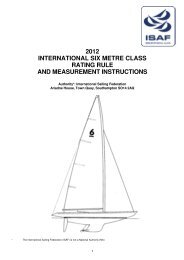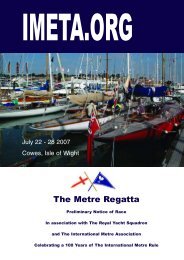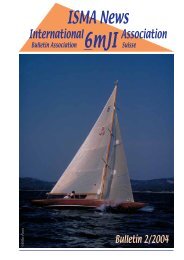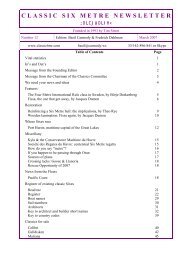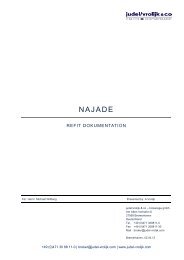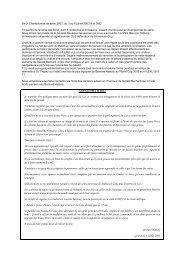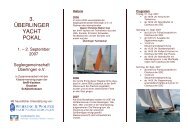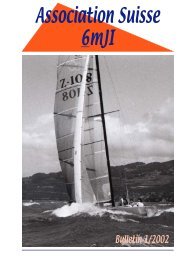ISMA News - Association Suisse 6mJI
ISMA News - Association Suisse 6mJI
ISMA News - Association Suisse 6mJI
Create successful ePaper yourself
Turn your PDF publications into a flip-book with our unique Google optimized e-Paper software.
60<br />
Some Thoughts for the Classics<br />
<strong>ISMA</strong> <strong>News</strong> International <strong>6mJI</strong> <strong>Association</strong><br />
As competition hots up in the Classics there are various issues that will need to be addressed in order that a level playing<br />
field for the Classic Fleet can be established .<br />
Here are some thoughts which are my personal comments ( in Italics ) on the Draft Classic Rules produced by Matt<br />
Cockburn , Tim Street and Tim Russell .<br />
I have interposed my thoughts into this document to set a background for my thoughts which are elaborated later .<br />
1 A Classic Six-Metre is a boat designed and built prior to 31st December 1965.<br />
2. All boats must conform to current International Six-Metre Class Rules, including deck equipment, mast<br />
and rigging.<br />
I think that it might be advisable for further Classic Rules to be introduced - see notes on sail girths and materials. Also<br />
do all Classic Sixes have cockpit areas that conform ? if so should they not be allowed the cockpit areas with which they<br />
were originally rated ? or indeed find themselves with - has anyone checked this ?<br />
3. The hull shape shall be consistent with the original design intent. Classic boats are permitted only one<br />
moving underwater appendage, which shall be a rudder mounted on the aft end of the keel, unless otherwise<br />
designed originally. Boats built to Rule 1 and Rule 2 may be updated to a configuration consistent with a<br />
pre-1965 interpretation of Rule 3 but, unless incorporated in the original design, are not permitted a bustle,<br />
a spade rudder or a separate skeg and rudder configuration. (see Note 1 below).<br />
Sounds most sensible<br />
4. A boat whose underwater shape has been modified to a post-1965 design, may regain its’ classic status, if<br />
the boat is returned to its’ pre-1965 underwater configuration and re-measured.<br />
Again sounds most sensible .<br />
5. Laminated frames using modern glues are permitted to replace broken or decayed frames. Reinforcement<br />
of the hull by the addition of a maximum of four laminated or plywood ring frames, using modern glues, is<br />
permitted: two in way of the mast partners and two in way of the running backstay turning blocks or<br />
attachments only.<br />
Why should owners not be able to repair/restore boats as they see fit - Scantling Rule constraints are intended only to<br />
prevent advantage being gained by building lighter than the Rule . Clearly any repairs should not be lighter than the<br />
structure that they replace but that is alraedy<br />
6. With the exception of decking, ring frames, splash boards and minor outfitting items of a non-structural<br />
nature such as storage lockers and floorboards, the use of plywood is not permitted in restoration. However,<br />
this rule shall not invalidate the use of plywood to effect short-term temporary repairs.<br />
See 5. above - also this feels a curious Rule suggestion Plywood appears to date from the 1880s and its<br />
production was a major industry by the 1920s .<br />
Plywood ( Its Production Uses and Properties ) of 1932 offers film bonded plywood from Siempelkamp in<br />
Germany and phenol/formaldehyde bonding also .<br />
7. Replacement planking shall conform to the original construction method and scantlings. An additional<br />
single external wooden veneer skin is permitted, provided any such addition is permitted within the current<br />
International Six-Metre Class Rules. (see Note 2).



